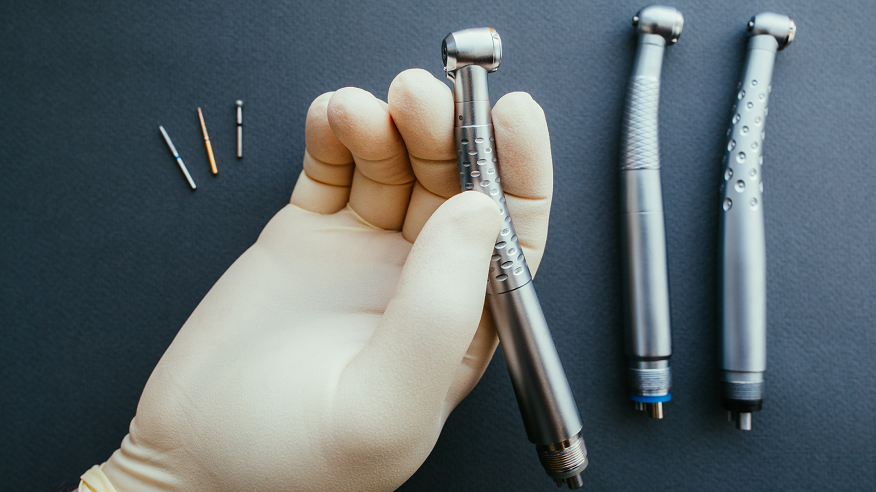What Is The Life Expectancy Of A Dental Handpiece?
5 min read
A dental headpiece, more commonly referred to as a dental handpiece, is an essential tool in a dentist’s arsenal. It is used for a variety of procedures ranging from simple cleanings to intricate surgeries. But how long can one expect these vital tools to last?
Understanding A Dental Handpiece
Before we explore the life expectancy of a dental handpiece, it’s crucial to have a comprehensive understanding of what this remarkable device entails and the vital role it plays in dental procedures. A dental handpiece, a precision tool operating at high speed, serves a multitude of purposes including the removal of decay, the meticulous polishing of fillings, and the precise alteration of prostheses such as crowns and bridges. By harnessing its advanced capabilities, dental professionals are empowered to provide optimal oral care, ensuring the well-being and satisfaction of patients.
Factors Affecting The Life Expectancy Of A Dental Handpiece
The life expectancy of a dental handpiece is influenced by numerous factors, each playing a crucial role in determining its longevity. These factors encompass the frequency of use, the diligence of the maintenance routine, and the inherent quality of the handpiece itself. By considering these aspects, dental professionals can make informed decisions to ensure optimal performance and durability of their handpieces, ultimately enhancing the overall efficiency and effectiveness of their work.
Frequency of Use
The lifespan of a handpiece is directly influenced by its frequency of use. As the tool is employed more often, the mechanical components within experience wear and tear, ultimately resulting in a shorter overall lifespan. This relationship underscores the importance of proper maintenance and care to ensure optimal durability and performance.
Maintenance Routine
Regular cleaning and lubrication are vital for maximising the lifespan of a dental handpiece. By implementing proper maintenance practices, such as thorough cleaning and regular lubrication, you can effectively prevent corrosion, minimise wear, and ensure that the handpiece remains in optimal condition for an extended period of time. This not only helps to enhance its longevity but also ensures that it consistently delivers high-performance results, allowing dental professionals to provide the best possible care to their patients.
Quality of The Handpiece
The quality of the dental handpiece is of utmost importance when it comes to its durability. Opting for high-quality tools crafted with superior materials and employing advanced engineering techniques can significantly prolong their lifespan. These meticulously designed handpieces undergo rigorous testing to ensure optimal performance, providing dentists with reliable and long-lasting instruments for their practice. Investing in such top-notch equipment not only enhances efficiency in dental procedures but also contributes to a seamless patient experience.
The Typical Life Expectancy of a Dental Handpiece
Based on the factors mentioned above, a high-quality dental handpiece, when properly maintained and used moderately, has the potential to last between three to five years. This estimate, however, may vary depending on individual circumstances such as frequency of use, maintenance practices, and operational conditions. It’s important to note that regular servicing, cleaning, and adherence to manufacturer’s guidelines can significantly contribute to the longevity and optimal performance of the handpiece. By investing in routine maintenance and adopting best practices, dental professionals can ensure that their handpieces continue to deliver reliable and efficient performance throughout their lifespan.
Common Issues and Repairs of Dental Handpieces
Despite their robust construction and meticulous design, dental handpieces are susceptible to a range of issues due to their complex operational nature and frequent use. Two of the most prevalent issues include bearing failure and turbine problems.
Bearing Failure
Bearing failure is a common issue that can afflict dental handpieces. This typically manifests as excessive noise, vibration, or a decrease in speed during operation. The primary cause is generally associated with inadequate cleaning and lubrication, leading to accelerated wear and tear on the bearings. Repair typically involves replacing the bearings, and preventive measures include regular cleaning, lubrication, and servicing based on manufacturer guidelines.
Turbine Problems
Turbine problems are often a result of prolonged use or a lack of regular maintenance. Symptoms of turbine malfunction might include a reduction in power or cessation of operation. Again, proper cleaning and lubrication are key to preventing these issues, but if a turbine problem does occur, replacement is usually the most effective solution.
Regardless of the specific problem, proactive maintenance is the best way to prevent these common issues and prolong the life of a dental handpiece. By following rigorous maintenance schedules and promptly addressing any issues that arise, dental professionals can ensure their tools remain in optimal condition, thereby optimising their practice’s efficiency and the quality of care they provide to their patients.
Remember: prevention is always better than cure, especially when it comes to maintaining the longevity and performance of your dental handpieces.
Benefits of Professional Servicing
Professional servicing offers numerous benefits that can significantly enhance the lifespan and performance of dental handpieces. First and foremost, it ensures expert oversight and meticulous care, something that’s necessary given the complex nature of these instruments. Trained technicians have the knowledge and expertise required to identify and address potential issues that may not be apparent to the untrained eye, thereby preventing minor problems from escalating into major malfunctions.
Furthermore, regular professional servicing ensures that all maintenance is carried out in accordance with the manufacturer’s guidelines, which is crucial for preserving the integrity and functionality of the handpiece. It also negates the potential for accidental damage that can occur when non-specialists attempt to clean or repair these delicate instruments.
Lastly, professional servicing can provide peace of mind, allowing dental professionals to focus on their primary responsibilities – providing excellent patient care. With the assurance that their tools are maintained to the highest standards, they can confidently carry out their work, knowing their handpieces will perform reliably and efficiently.
Conclusion
The lifespan of a high speed dental handpiece is influenced by several factors, including their quality, maintenance, and professional servicing frequency. Investing in high-quality tools and adhering to strict maintenance routines significantly enhances their longevity and performance. Professional servicing provides expertise and care, ensuring the operational integrity of handpieces. This allows dental professionals to focus on delivering exceptional patient care with confidence, knowing their tools are robust, reliable, and maintained to the highest standard.





